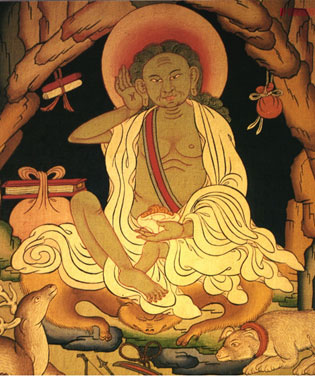—————-
MILAREPA
The Saint-Poet and His Songs
by Ivy Hsu

Who Was Milarepa
Milarepa was a yogi, sage, and poet much-beloved by the Tibetan people. He was often depicted as in the illustration shown here, with a hand raised to his ear in a listening gesture, symboling his way of teaching the Buddhist wisdom through songs. His skin had a greenish hue, due to the fact that over the many years of meditation, his diet often consisted of nothing but nettle soup. He was also significant to the development of Buddhism as an example of an ordinary person who attained enlightenment in a single lifetime. His life story was a testament of the power of both good and evil.
Early Life – Becoming a Sorcerer
Milarepa was born around 1040 A.D. His father passed away when he was seven. According to the local custom, the family’s property was entrusted to his uncle until Milarepa came of age. Unfortunately, his uncle and aunt were greedy and mean-spirited. They took over the property and subjected the widow and the children to years of hardship as their servants.
To avenge the mistreatment, Milarepa’s mother sold the only asset she possessed and sent him on a journey to learn black magic. Milarepa abode his mother’s wish well. He returned to his village after becoming a powerful sorcerer, and found his uncle’s family just about to celebrate his cousin’s wedding. Using his magic power, he brought about a hailstorm and destroyed the uncle’s crops. Furthermore, he collapsed the roof of the house, killing his cousin and many people at the wedding banquet. At last, he brought the uncle to his knees.
Meeting Marpa
Instead of rejoycing in the long-sought revenge, he became deeply remorseful of his deeds. This led him to renounce all worldly goods and embark on a second journey, this time in search of a teacher who’d quiet his troubled mind. He finally met Marpa, a tantric master and a remarkable scholar. Called “Marpa the Translator”, he was known for introducing many works from India to Tibet.
To test the young man’s will and to purge his sins, Marpa acted cruelly and subjected Milarepa to much physical hardship. Over and over, he ordered Milarepa to build a tower, tore it down, and returned all building materials to where he found them. The young man never wavered. Finally Marpa was satisfied and initiated Milarepa. However, instead of grooming Milarepa into a scholar like himself, Marpa set him off on a life of meditation.
Milarepa remained much devoted to his teacher all his life. This devotion to one’s master is quite characteristic of Tibetan Buddhism. As Sogyal Rinpoche put it, “It is my devotion to my masters that gives me the strength to teach, and the openness and receptivity to learn, and go on learning.”
Meditating in Solitude
In the subsequent years he lived in caves in the mountains, meditating in solitude. He also practiced inner-heat yoga, which helped sustain him in the harsh physical environment. Many of his songs were about his inner reflection in the meditation process. He also had poem exchanges with dakinis (sky-dancers) and demons. The conversion of demons and demonesses of the traditional belief to protectors of Buddhism by renowned masters constitutes a central and unique part of the Tibetan Buddhist history.
From time to time he went down to the villages and preached by way of song. He had many disciples and followers, who later compiled his poems into the book The Hundred Thousand Songs. After Milarepa passed away, those who were at the cremation ceremony witnessed his relics being carried up into the sky by dakinis.
A Sample of Milarepa’s Songs
– Song to the Rock Demoness
– Song of the Three Teachings
– Source : kalachakra.org




